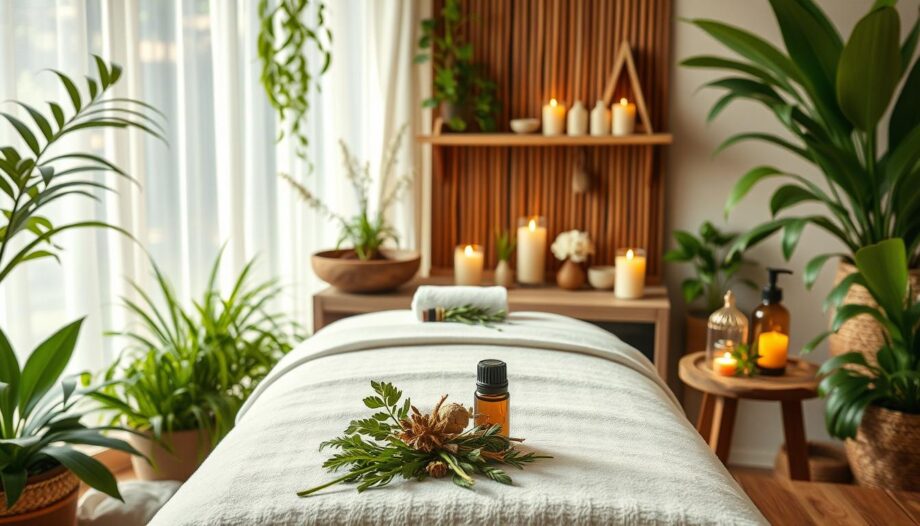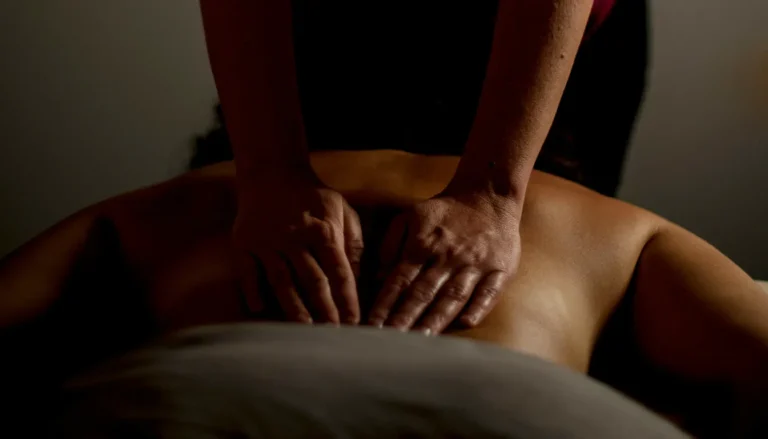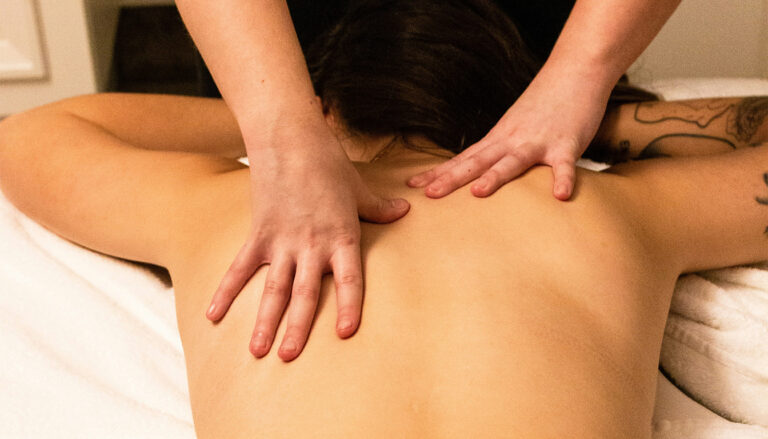Ayurvedic massage, also known as Abhyanga, is a 5,000-year-old practice from India1. It uses warm oils and special massage techniques to heal the body, mind, and spirit. This therapy aims to balance the body’s constitution and stimulate energy points for better health and mental clarity.
Ayurvedic massage is a complete wellness practice based on ancient Ayurveda principles. Ayurvedic massage treatments, like Abhyanga, Shirodhara, and Udvartana, use natural oils and unique techniques. They target energy points and balance doshas to improve health and vitality.
Looking for deep relaxation, better circulation, or a holistic wellness approach? Ayurvedic massage offers many benefits. This guide will explore its origins, principles, and techniques. It aims to help you start a wellness journey of self-discovery.
Origins and Principles of Ayurvedic Massage
Ayurvedic massage comes from ancient Indian philosophy of Ayurveda. It focuses on balancing three life forces or doshas—Vata, Pitta, and Kapha2. These doshas shape our physical, mental, and emotional health. Ayurvedic massage aims to balance these forces for holistic health.
Understanding the Three Doshas
Each person has a mix of the three doshas, shaping their constitution and health2. Vata types are creative and flexible but may face anxiety and sleep issues. Pitta individuals are driven and confident but can be irritable and have digestive problems. Kapha types are nurturing but may struggle with sluggishness and weight gain.
The Role of Balance in Ayurvedic Philosophy
Ayurveda’s core is balance between the doshas2. When balanced, body, mind, and spirit work best. Ayurvedic massages are customised to each person’s dosha, aiming to restore balance and well-being2.
Historical Development in Indian Medicine
Ayurveda is one of the oldest holistic health systems, spanning over 3,000 years2. It originated in India and has become a key part of the country’s culture3. In India, practitioners must complete detailed education and training to practice legally2. In the US, regulations and certification vary by state, with no national standards2.
Ayurvedic medicine faces challenges in the West despite its rich history and growing popularity. While it can complement standard care, there are concerns about safety and quality23. Yet, Ayurveda’s holistic principles continue to attract those seeking a more integrated health approach.
What Is Ayurvedic Massage and Its Core Techniques
Ayurvedic massage is a holistic healing practice that aims to balance the body’s energy and promote overall well-being4. It focuses on stimulating the body’s vital energy centres, known as marma points, and enhancing the flow of prana, or life force5.
Effleurage, or Samvahan, is a key technique. It involves long, gliding strokes to soothe and relax the muscles4. Petrissage, or Mardan, uses kneading movements to target deeper tissues and promote blood circulation4.
Tapotement, or Tapatan, is a rhythmic tapping technique used to stimulate the body’s energy points and improve lymphatic drainage4. Friction, or Pesin, involves quick back-and-forth movements to generate heat and break down muscle tension4.
These techniques are performed with warm, aromatic oils selected based on the individual’s dosha, or mind-body constitution4. The oils nourish the skin, transport healing properties to the cells, and help the therapist and client breathe in sync during the massage4.
After the massage, Ayurvedic practitioners provide personalised recommendations for diet, exercise, nasal sprays, herbal remedies, sleep, meditation, and yoga4. These recommendations support the client’s overall health and well-being4.
| Ayurvedic Massage Technique | Description |
|---|---|
| Effleurage (Samvahan) | Long, gliding strokes to soothe and relax the muscles |
| Petrissage (Mardan) | Kneading movements to target deeper tissues and promote blood circulation |
| Tapotement (Tapatan) | Rhythmic tapping to stimulate energy points and improve lymphatic drainage |
| Friction (Pesin) | Quick back-and-forth movements to generate heat and break down muscle tension |
Ayurvedic massage is a holistic and therapeutic practice that aims to restore balance and harmony within the body, mind, and spirit6. It uses core techniques and personalised oils and recommendations to promote overall health and well-being5.
“Ayurvedic massage is not just a physical experience, but a journey towards self-discovery and inner peace.”
Types of Ayurvedic Massage Treatments
Ayurvedic massage offers many special treatments for overall health. You can choose from Abhyanga full-body massage to Shirodhara third-eye treatment. Each therapy is designed to meet different health needs and preferences.
Abhyanga: Traditional Full-Body Massage
Abhyanga is a popular Ayurvedic massage known for its nourishing effects7. It’s a full-body massage done by two therapists. They use warm, infused oils to boost energy and balance the body.
Shirodhara: The Third-Eye Treatment
Shirodhara is a special treatment where warm oil is poured on the forehead7. It’s great for those with headaches, insomnia, or anxiety. It calms the mind and brings deep relaxation.
Udvartana: The Powder Massage
Udvartana is a dry massage with herbal powders for skin cleansing and exfoliation78. It’s good for detox, weight loss, and better blood flow.
Marma Therapy: Energy Point Healing
Marma therapy targets energy points in the body7. It balances energy and helps organs work better.
Ayurvedic massages offer many benefits for health and well-being. They help with relaxation, detox, and healing. Each treatment is tailored to meet your needs.
“Ayurvedic massage is not just a physical experience, but a journey towards harmony and balance within the body, mind, and spirit.” – Dr. Vasant Lad, renowned Ayurvedic physician
Essential Oils and Materials Used in Ayurvedic Practice
Ayurvedic massage uses special oils and materials. These are chosen based on a person’s unique dosha, or mind-body type9. The oils, often made with herbs and spices, are warmed before use. This helps nourish and balance the body, mind, and spirit10.
Common oils include sesame, coconut, and almond. Each has its own benefits. For example, sesame oil helps with Vata dosha, while coconut oil balances Pitta9. Practitioners also add herbs like cinnamon and cardamom to make custom blends10.
Ayurvedic massage also uses herbal powders and special tools. For example, Udvartana is a full-body exfoliating massage10. Tools like the oil-pouring vessel in Shirodhara treatments are key to the experience10.
Choosing oils and materials in Ayurvedic practice is careful. It considers a person’s dosha, balance, constitution, and environment9. Ayurvedic massage aims to improve physical, mental, and emotional health. It helps people find balance and harmony9.
“Ayurveda believes that daily oil rubs lead to various health benefits including musculoskeletal and nervous system health, circulation and lymph drainage, improved sleep patterns, softer skin, healthy vision, graceful aging, lustrous hair, firm limbs, increased longevity, nourishment for the whole body.”9
| Dosha Type | Recommended Oils |
|---|---|
| Vata | Plain untoasted sesame oil, Vata Massage Oil, Ashwagandha/Bala Oil, Mahanarayan Oil |
| Pitta | Sunflower Oil, Coconut Oil, Pitta Massage Oil, Bhringaraj Oil, Brahmi Oil, Neem Oil |
| Kapha | Kapha-pacifying oils are suggested for individuals with dominant kapha dosha qualities to balance the heavy and cool characteristics of kapha dosha. |
Conclusion: Embracing Ayurvedic Massage for Holistic Wellness
Adding Ayurvedic massage to your wellness routine brings many benefits. It can improve blood flow, reduce stress, and help with detoxification. It also boosts your overall health11. Doing it regularly, especially with the seasons, makes these benefits even stronger12.
It’s key to talk to an Ayurvedic expert. They can help find the right treatments for you. This ensures you get the most out of Ayurvedic massage for your health11.
Ayurvedic lifestyle practices, like Ayurvedic self-care and natural healing, complement Ayurvedic massage well. They help improve your overall well-being13. By following Ayurveda and adding Ayurvedic massage to your routine, you start a journey to better balance and health.
Ayurvedic massage is great for stress relief, better skin, and more calm. It’s a traditional way to care for your body, mind, and spirit111213. By choosing this ancient healing, you can live a life full of energy and holistic wellness.
FAQ
What is Ayurvedic massage?
Ayurvedic massage, or Abhyanga, is an ancient Indian healing method. It’s over 5,000 years old. It uses warm oils and special massage techniques to balance body, mind, and spirit.
What are the principles of Ayurvedic massage?
Ayurvedic massage is all about balance. It focuses on three main types: Vata, Pitta, and Kapha. These types represent different energy patterns in our bodies. The goal is to keep everything in harmony.
What are the core techniques used in Ayurvedic massage?
The massage uses several techniques. These include Effleurage, Petrissage, Tapotement, and Friction. They’re done with warm oils to help the body and mind feel better.
What are the different types of Ayurvedic massage treatments?
There are many types of Ayurvedic massage. You can get a full-body massage, or try Shirodhara where oil is poured on your forehead. There’s also Udvartana and Marma therapy for different needs.
What materials are used in Ayurvedic massage?
Ayurvedic massage uses oils like sesame, coconut, and almond. These oils are often mixed with herbs and spices. Herbal powders and special tools are used too, depending on the treatment.





